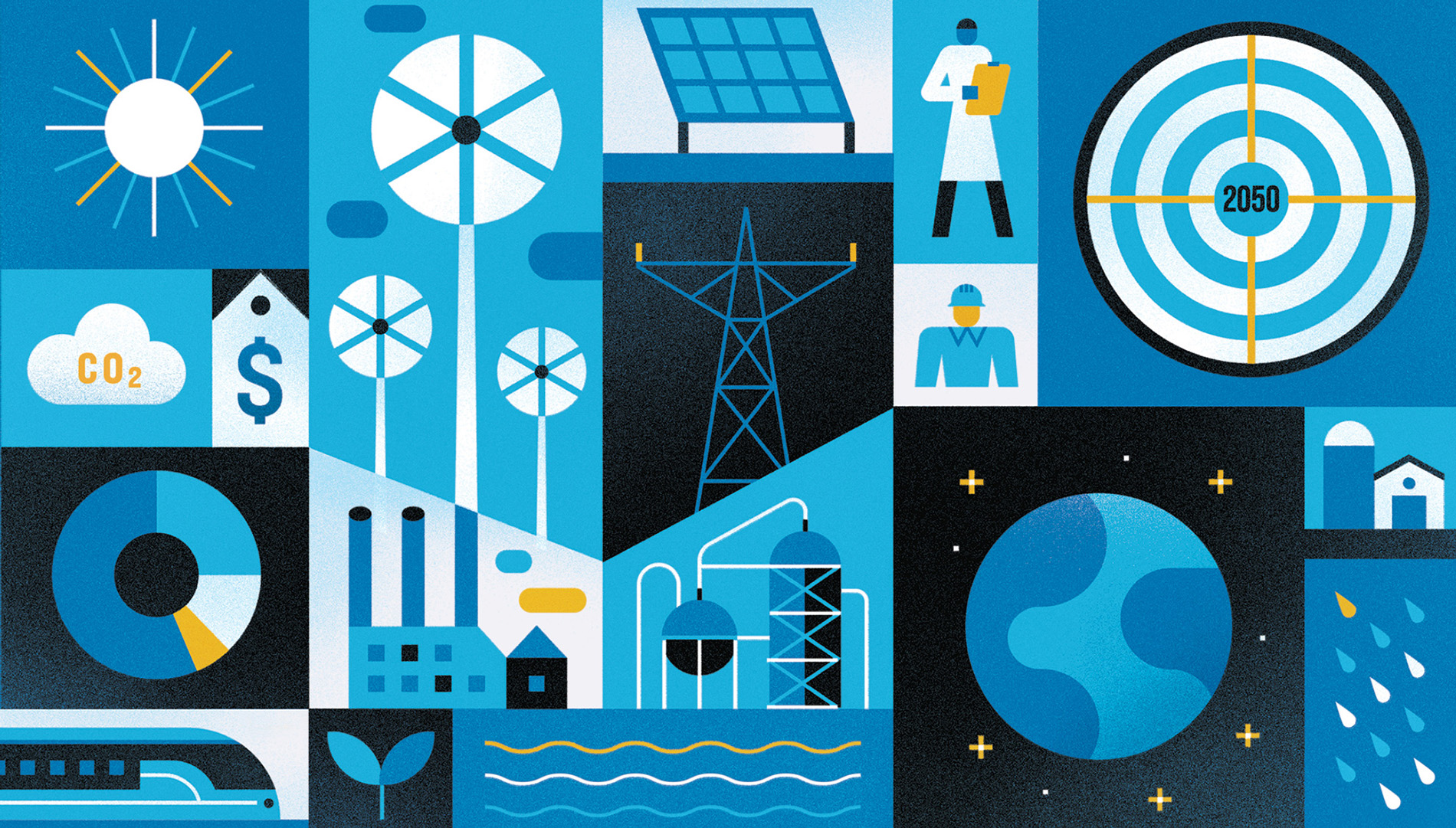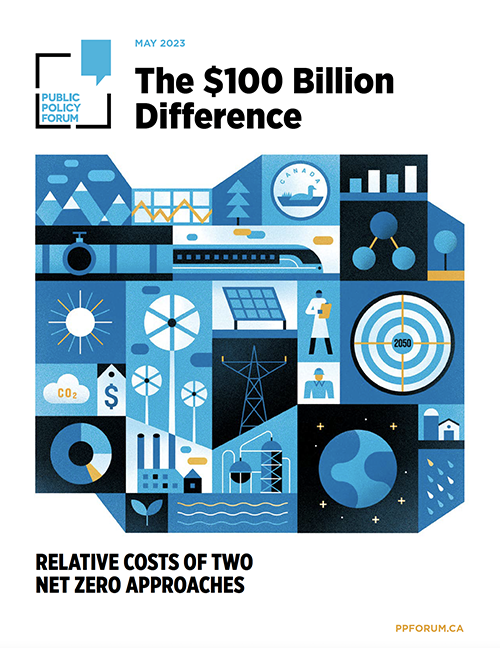
The $100 Billion Difference
Relative costs of two net zero approachesIn launching its Energy Future Forum in 2019, the Public Policy Forum set out as its mission “to develop practical measures that help Canada meet or exceed our 2030 emissions targets on the way to a net zero future, and that strengthen an innovative economy, deepen shared prosperity and enhance national unity.” From the beginning, PPF was concerned that the public dialogue around climate and energy involved people talking past each other, whereas climate policy in a democracy would require a strong and enduring consensus among the governed.
In our early meetings, some espoused the view that Canada was such a small part of global emissions that the cost of action (economically, socially and politically) outweighed the potential climate gain. We sought to tamp down this kind of reasoning with an analogy to the 20th century’s world wars: imagine telling our Allies that Canadian soldiers constituted such a small percentage of the overall effort that it made no sense to send them to the front.
Meanwhile, others failed to pay adequate heed to the word ‘transition’ in “energy transition.” They tended to conflate greenhouse gas emissions with fossil fuels themselves. In so doing, they ignore a possible solution set that seeks to decarbonize oil and gas production, allowing, where it makes sense, for their continued use with reduced emissions while the demand side makes its adjustments. The idea remains to get emissions out in the least costly and disruptive manner.
This basic cleavage re-appeared in our 2022 Blueprint for Canada’s Net-Zero Transition. The report observed that two basic narratives continued to vie for the hearts and minds of Canadians. We called one the aggressive decarbonization model. It involves a two-track strategy of investing in both non-emitting energy sources and in lowering emissions from oil and gas production.
PPF labelled its competing narrative the accelerated phaseout model. By that, we meant measures that would suppress supply of fossil fuels at a faster pace than demand would otherwise dictate. This could be operationalized directly in the form of a cap on the production of fossil fuels — although a production cap in Canada is almost certainly beyond the powers of the federal government. Then again, policy could just as easily shrink production via indirect means, such as limiting pipeline or other infrastructure approvals and permits, constraining or discouraging investment, or setting an emissions cap level so stringent it is only achievable through production cuts. Directly or indirectly, an accelerated phaseout model would deny existing producers the opportunity to innovate their way to a net-zero future.
By and large, the logic of many government policies, including recent tax credits, adheres to the aggressive decarbonization model. But some policy decisions, and much rhetoric, come closer to an accelerated phaseout.
Having described these two approaches, we felt the need to understand their relative consequences. Would one over the other make a difference to the economic welfare of Canadians? Would one more readily deliver emissions reductions?
We met with Vancouver-based Navius Research, a highly respected environmental modelling firm that grew out of Simon Fraser University and which has done work in the past for all orders of governments, environmental groups, labour, academia and industry. Navius told us that the impacts of the two alternate pathways to net zero emissions in 2050 could be measured. We agreed that understanding these differences would better inform policymakers and public discourse.
Navius also included a third pathway, where Canada implements only those policies that have already been announced, and does not reach net zero. This scenario was included for comparison purposes. We should all be clear — this is not a viable scenario for Canada, as per the military analogy above, or for the planet. Climate change must be addressed.
With that said, the results provide important context for Canada’s climate policy. Five takeaways captured our attention:
- We are not headed to net zero on the basis of current policy. In fact, Navius projects Canada is likely to narrowly miss even our 2030 target. Achieving our net-zero ambitions will require additional policy, whether consistent with an accelerated phaseout or aggressive decarbonization.
- An accelerated phaseout introduces economic pain with no added environmental gain. Both pathways arrive at net zero but with unequal economic impacts along the way. Canada grows at a rate that is 0.1% slower per year under an accelerated phaseout than aggressive decarbonization. This apparently small difference compounds over time, leading to $100 billion excess lost GDP in 2050, a three percent contraction of the overall economy. This essentially amounts to a deep recession without a recovery ever materializing. The lost output carries forward each year in perpetuity.
- This gap in growth falls disproportionately on oil and gas producing provinces, particularly Alberta. About $60 billion of Canada’s $100 billion growth shortfall falls directly on Alberta. The province experiences miniscule growth of less than one percent for the 30 years from 2020 to 2050, according to the model. If anything, Navius expects its assumptions may actually be underestimating the severity of this impact.
- The incomes of everyday Canadians decline as well in response to the phasing out of oil and gas. Navius tested this result under different assumptions and, while the number was sometimes higher or lower, the direction was always the same when Canadian workers lose one of their most productive and highest-paying sectors under the accelerated phaseout model. Think of the hollowing out of the U.S. Midwest with workers going from pay of $30 or more an hour to something closer to half that.
- Canada’s trade balance naturally weakens with the curtailment one way or another of its largest export category. The accelerated phaseout approach leads to net exports declining by nearly twice as much as the aggressive decarbonization model. Perhaps less obvious is that imports also fall in the overall economy because Canadians have lower incomes to spend on imports.
Once the modeling results were in, PPF convened a roundtable in March 2023 to put the assumptions and outcomes under a collective microscope.
Some participants, largely from environmental groups, argued that the entire exercise was based on a false premise. In their opinion, nobody is advocating for an accelerated phaseout. They regarded that as a straw man; that, despite the fact that a recent report by the Winnipeg-based International Institute for Sustainable Development called for “an oil and gas production phaseout by 2034 for rich countries”; that there was a strong push at last year’s COP in Egypt to include language in the final agreement calling for a phaseout of all fossil fuels as advocated by Environmental Defence Canada, among others; or that the objective of the Beyond Oil and Gas Alliance, which includes the province of Quebec, is to phase out oil and gas production worldwide.
Those are just some of the phaseout interventions related to direct means. Indirect means, such as divestment campaigns, are meant to arrive at the same end.
A model cannot produce a definitive projection of the future. No model from 30 years ago could have projected the technology and events that have shaped our world of 2023, for example. Nobody would have forecast negative-priced oil in 2020 or the run-up in prices following the invasion of Ukraine. Similarly, the Navius model cannot fully grasp Canada’s emerging opportunities in such net-zero sectors as critical minerals, hydrogen or industries we may not yet imagine.
The value in a model, rather, is informing the relative impacts of comparable paths in a way that can help to inform policymaking. On this front, the modelling is clear. Oil and gas production can be a part of a net-zero future if significant investments are made to transform the sector. The alternative causes extensive economic damage while not bringing us any closer to our climate change goals.
The energy transition is complicated and difficult stuff. Climate policy will have to continue to unfold, given that current measures do not yet appear to bring emissions down sufficiently. One cannot lose sight of the Energy Future Forum’s original principles that a policy regimen that must be executed over several decades will have to maintain political support throughout. The only way to win the battle is to be environmentally, economically and politically sound and ensure that energy reliability and affordability are not forsaken as we move toward net zero.
There is no way of doing nothing in the face of the climate emergency. The question is what course produces the best environmental outcome for Canadians while causing the least disruption possible on the way to net zero?
It is in that spirit that we present the Navius findings.

– Edward Greenspon
President and CEO, Public Policy Forum
Read more: Eisler: Is Vaclav Smil the Voice of Reason We All Need to Hear?;
Disaster Risk, Climate Change and National Security Governance in Canada;
Nature-based Solutions: Some of the Answers to Climate Change Come Naturally








